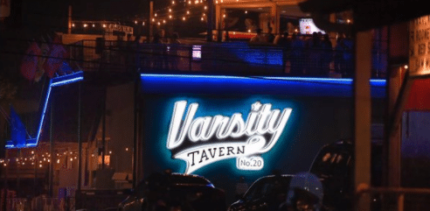
The carving depicting Confederate Civil War figures Thomas “Stonewall” Jackson (from left), Robert E. Lee and Jefferson Davis on Stone Mountain in Georgia is the subject of increased scrutiny following the deadly violence in Charlottesville, Va., on Aug. 12, 2017. One Democratic candidate for governor is calling for the carvings to be removed. (AP Photo/John Bazemore, File)
In Virginia, emotions are running hot. Following the death of one and the injuring of 19 after a car plowed into a group of counter-protesters at a white nationalist protest in Charlottesville, the conversation has turned from understanding what happened to preventing it from happening again.
During a contentious city council meeting on August 21 — where an expedited plan to remove the city’s Confederate memorials was agreed upon — many city residents asked why the police maintained such a subdued presence during the protest. In recent months, Charlottesville has become a hot spot for white nationalist protests and gatherings.
Elsewhere, the ACLU has called for legislation that would overturn the Virginia state law protecting war memorials, the NAACP has called for the renaming of two schools currently named for Confederate leaders, and there are talks about renaming Virginia streets honoring the Confederacy.
“Virginia’s monuments and memorials to Confederate war figures must go,” the ACLU said in a statement. “Regardless of origin or historical context, today they are inciteful symbols of hatred and bigotry to which white supremacists are drawn like moths to a flame.”
Historically, acts of violent racial hate have galvanized public opinion in significant ways. Televised coverage of police brutality toward protesters during the civil rights movement helped create the groundswell that led to the passage of the Civil Rights Act of 1964 and Voting Rights Act of 1965, for example.
However, there seems to be a disconnect today. The popular push to remove the symbols of racial hate may have surpassed the push to address the effects of racial hate. Increasingly, the national conversation has swung from addressing race-based discrimination to discussing race-based symbolism, to the detriment to the former.
“From the inception of this nation, white supremacist ideology was used to justify genocide and slavery. And so, the problem of collective memory extends far beyond Confederate memorials,” Crystal Marie Fleming, associate professor of sociology and Africana studies at the State University of New York at Stony Brook, wrote for The Root.
“Removing memorials to white supremacy in the United States is not simply a matter of knocking down statues of Robert E. Lee. It’s relatively easy for some to see the Confederate flag as an emblem of hatred and white supremacy. But slavery, lynchings, Jim Crow, mass incarceration and centuries of systematic racism all happened under the star-spangled banner.”
Understanding Racism Today
Discussions on racism today have become a political quagmire. Attempts to address major concerns regarding the equitable treatment of individuals based on race tend to move into one of two choke points. At one end, there is the argument that racism today does not exist, is no longer a significant concern today, or is limited to extremists.
At the other end, there is the argument that racial discrimination persists because policies that promote or encourage “victimization” is allowed to continue unchecked. “The MSM [Main Stream Media] spends too much time on cop-on-Black crime and not enough time on the systematic racism of socialism and welfare perpetrated by the same Democrats who used the KKK to enforce Jim Crow and suppress Blacks for decades,” Pablo Solomon, artist, designer, and a regular conservative commentator, told Atlanta Black Star.
The Problem with Symbols
The argument of removing the memorials to an ‘enemy combatant’ is an important one. As Ta-Nehisi Coates pointed out, regarding HBO’s decision to green-light a Confederacy-revisionist themed series, Confederate, “The symbols point to something Confederate’s creators don’t seem to understand — the war is over for them, not for us. At this very hour, black people all across the South are still fighting the battle which they joined during Reconstruction — securing equal access to the ballot — and resisting a president whose resemblance to Andrew Johnson is uncanny.”
The problem in using the removal of racial symbolism to address racial hate lies in the fact that racial hate does not come from racial symbols; focusing on the removal of the monuments is akin to addressing the symptoms and not the disease. In a way, focusing on removing the monuments is another choke point, effectively drawing conversation of racial inequitably to a politically drawn tangent.
“While the removal of Confederate symbols of white supremacy is completely justifiable and repulsively long overdue, it is also important to recognize the fact that the flag of the Union — and, indeed, our current, actual flag — is an emblem of white supremacist racism, too. The nation that existed prior to the Civil War was racist. That country is still racist today. It has never not been racist,” Fleming added.
What is Racial Hate?
This does not diminish the fact that Charlottesville happened. To understand the violence that happened there, one has to look at the nature of racial hate.
According to the Southern Poverty Law Center, there are 917 hate groups current active in the United States. This number represents a marked increase from the 794 there were in 2014 — the end of a three-year decline due to a transitioning from on-the-ground extremist protesting to Internet-based activities. The resurgence of the extreme fringe was influenced by reports of demographics change — which suggests that this nation will be minority-majority by 2040 and that many states are now minority-majority due to Latino immigration.
However, many feel that the extreme fringe’s reemergence had a singular flash point.
“[Trump] kicked off the campaign with a speech vilifying Mexican immigrants as rapists and drug dealers,” Mark Potok, writer and expert on the Radical Right and formerly a senior fellow with the SPLC, wrote. “He retweeted white supremacist messages, including one that falsely claimed that black people were responsible for 80% of the murders of whites.
“He credentialed racist media personalities even while barring a serious outlet like The Washington Post, went on a radio show hosted by a rabid conspiracy theorist named Alex Jones, and said that Muslims should be banned from entering the country. He seemed to encourage violence against black protesters at his rallies, suggesting that he would pay the legal fees of anyone charged as a result.”
Trump has argued against the removal of Confederacy monuments, stating that it is a slippery slope that will eventually lead to the demand to remove monuments of slaveholders like George Washington and Thomas Jefferson.
While the Trump presidency cannot be fairly blamed for creating the bias that is being seen today, it can be blamed for granting license for it to be expressed openly. In the first 34 days since Election Day 2016, there were 1,094 incidents of racial hate. The highest concentration happened on the first day after Trump’s election.
Among the groups that have emerged in the Trump era are anti-Muslim hate groups, which have seen steady growth for the last two years, and neo-Confederate groups, which were in sharp decline before Election Day due to the collapse of several Ku Klux Klan groups in the United States. Anti-government or “patriot” groups, which dominated the alt-right during the Obama administration, have fallen off due to a co-opting of their platform by Trump.
Growing Hate Means More Discrimination
With the decline in white birth rates and the growth of the Latinx community, means that the numbers of foreign-born American residents currently in the US is at levels last seen when the restrictive Immigration Act of 1924 was introduced. At the same time, the shell-shocked global industrial base has opened up, allowing for the outsourcing abroad of entire economic sectors that once made up the bulk of America’s non-college graduates’ career options.
In conversation with Atlanta Black Star, the psychologist Jerry D. Smith Jr. argues that racial hate is the application of fear in a system of racial discrimination. While racial discrimination comes from the human mind’s tendency to categorize things similar to itself the same way it categorizes itself, racial hate comes from a fundamental rejection of not only what is different, but what is threatening because it is different.
“The causes of this fear may be numerous, but often comes from a fear of losing one’s status, power, or station in life — as is often seen in some from majority cultures,” Smith noted. “It also may come from the fear of never-ending abuse — as may be seen among some from minority cultures.”
“When the fear factor is introduced, those in power (particularly, social and political power) often feel the need to protect themselves and their status by identifying and attacking the thing (i.e., group) that triggers the fear. In order to attack someone, there has to be an emotional detachment from them and the easiest way to do this is to denigrate and dehumanize them. When you have successfully dehumanized someone in your mind, you can engage in all kinds of violent actions toward them without remorse.”
The fact that hate has hijacked the conversation has grave consequences for a conversation on how racial discrimination impacts Black lives on a day to day level. An impact that won’t go away just because the obvious symbols of hate are removed from our streets. The realities of race inequality means:
- That for the majority of poor Blacks, it is easier to get a Big Mac than a fresh apple, as many low-income Black neighborhoods no longer have a supermarket or a green grocer;
- That the average Black family would have to live twelve lifetimes to have the same wealth as the average white family;
- That the average Black person is six times more likely to be sentenced for a drug-related charge, despite no difference per capita in drug use;
- That there are more African Americans that rent than own their home, that pay more than thirty percent of their take-home income as rent, and that lives in substandard housing — compared to whites;
- That a white child is twice as likely to be raised in a home that has at least one parent with a bachelor’s degree, is nearly twice as likely to get a bachelor’s degree or better for himself, and is more likely to have been read to, told a story, taught letters, visit a library, or do arts and crafts with other family members;
- That a Black person is more likely to be killed by the police;
- That a poor Black person can get better healthcare in Cuba than in the United States; and
- That an African American is more likely to be born in poverty, live their entire life in poverty, have children that are born in poverty and will die in poverty, and have grandchildren that were born in poverty and will die in poverty, than their white counterpart.
The tragedy of racial hate and the focus on racial symbol is that because they are monopolizing the national conversation, no one is talking about what it really means to be discriminated against.


